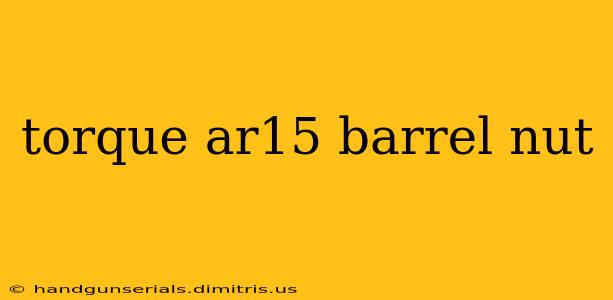The AR-15 platform's modularity is a significant advantage, but proper assembly is crucial for safety and reliability. One critical aspect often overlooked is the correct torque specification for the barrel nut. Getting this wrong can lead to catastrophic failure, so understanding the nuances is paramount. This guide delves into the intricacies of AR-15 barrel nut torque, providing you with the knowledge to assemble your rifle safely and effectively.
Understanding the Barrel Nut's Importance
The barrel nut serves as the foundation for the entire upper receiver assembly. It secures the barrel to the upper receiver, ensuring proper alignment and stability. An improperly torqued barrel nut can result in:
- Loose barrel: This can lead to significant accuracy issues, as the barrel shifts during firing.
- Damaged threads: Over-torquing can strip the threads on the barrel extension or the barrel nut itself, requiring costly repairs or replacement.
- Receiver damage: Excessive force can damage the upper receiver, rendering it unusable.
- Safety hazard: In extreme cases, a loose barrel can detach during firing, posing a serious safety risk.
Recommended Torque Specifications
There's no single universal torque specification for all AR-15 barrel nuts. Several factors influence the required torque:
- Barrel nut material: Different materials (e.g., steel, aluminum) have varying yield strengths.
- Barrel nut design: Some barrel nuts have different thread pitches or designs that affect torque requirements.
- Lubrication: The type and amount of lubricant used will impact the required torque.
Therefore, always consult the manufacturer's instructions for your specific barrel nut. This is the most reliable source of information. However, a general guideline is often provided as a starting point. Many manufacturers recommend a torque range between 35 and 60 ft-lbs.
Caution: Never rely solely on feel; always use a calibrated torque wrench.
Tools and Techniques for Proper Torque Application
Accurate torque application requires the right tools and techniques:
- Calibrated Torque Wrench: This is essential for ensuring consistent and accurate torque. A beam-style or digital torque wrench is recommended.
- Appropriate Socket: Choose a socket that precisely fits your barrel nut. Avoid using damaged or worn sockets.
- Lubrication: Apply a thin layer of high-quality gun grease to the barrel nut threads to reduce friction and prevent galling. Avoid excessive lubrication.
- Consistent Application: Apply torque smoothly and steadily to avoid sudden shocks or twisting.
Beyond the Torque: Ensuring Proper Installation
While proper torque is crucial, it's only one aspect of correct barrel nut installation. Other factors include:
- Cleanliness: Ensure both the barrel extension and barrel nut threads are clean and free of debris.
- Alignment: Ensure the barrel is properly aligned before tightening the barrel nut.
- Proper Indexing: Some barrel nuts require indexing to ensure correct gas system alignment.
Conclusion: Accuracy and Safety First
Understanding and adhering to the correct torque specifications for your AR-15 barrel nut is paramount for both accuracy and safety. Always refer to the manufacturer's instructions, use a calibrated torque wrench, and follow best practices for installation. Ignoring these steps can have serious consequences. Remember, safety should always be your top priority when working on firearms.

